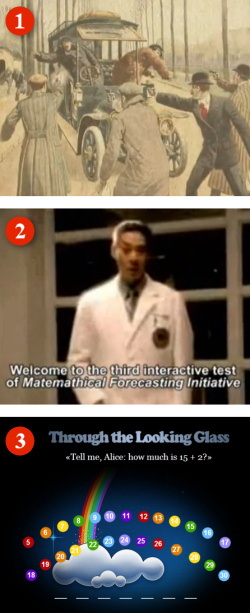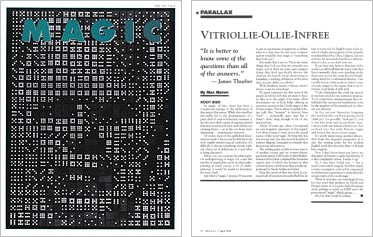My video tutorial “How to create two linking rings out of a newspaper” got viral (more than 50K visits in a couple of weeks) also raising some disappointment. Because the tutorial... was actually not a honest tutorial! Some labeled the video as “fake”, suspecting that CGI was involved in its creation. It was not. The missing part is the setup of the newspaper; with the proper arrangement, the video depicts something which can be performed live in front of an audience. (1)

It is not the first time I create something which violates its own narrative frame.
(1) This video has been shot in the style of an history documentary. Actually it is an interactive magic trick.
(2) This website seems to involve a scientific organization dealing with science and magic. Actually it is a repository of a spin-off series created by me and ispired by TV series Lost. The series is a collection of interactive magic tricks, dressed as 8 mm films.
(3) This math game for kids is something completely different: one plays with it with light heart, then discovers that it involves something deadly scary.
My contributions are experiments intended to go beyond the trivial use of YouTube as an eye on magic routines; my purpose is to hack the medium in provocative and puzzling ways, raising feelings which transcend mere entertainment. In this, I have been deeply influenced by Barry and Stuart; in their talk “Everything We’ve Learned So Far” – given during the Essential Magic Conference 2010 – they told:
Magic performances don’t have to be beautiful. You don’t have to make invoking wonder your main purpose. [...] We believe that if magic truly is an Art, then you can just as legitimately make your intention to provoke feelings of alienation, dissociation, or sadness. [...] We even thought that magic didn’t even have to be entertaining or even have an audience, and this led us to film pieces that were like short films. They weren’t performed for people, they were just performed for a camera with the fourth wall up, which means they were like insular stories. (2)
The best definition of magic I have ever found is the one given by Max Maven in his article “Vitriollie-Ollie-Infree”. (3) He starts by asking:
Just what is “magic”, anyway? If you were to ask an assortment of magicians to define what it is that they do, the most common answer would be that magic is “something that fools you.” But surely this is not so. There are many things that fool you that are certainly not magic, just as there are some quite magical things that don’t specifically deceive the observer. So, how do we go about trying to formulate a working definition of the term that, in turn, defies our efforts?

Max Maven, “Vitriollie-Ollie-Infree”, Magic 4 (1994). [BUY IT HERE]
Believe it or not, Max does offer such a definition. Unfortunately it defies any verbalization, and requires to read the article – which trascend the mere status of article, offering a trasformative experience in itself and evoking – in indirect way – the very core of the experience of magic.
1. I have seen it performed live by Ian Rowland in Abano Terme, Italy in 2004.
2. Barry and Stuart, “Everything We’ve Learned So Far”, Essential Magic Conference 2010.
3. Max Maven, “Vitriollie-Ollie-Infree”, Magic 4 (1994).
BY-NC-SA 4.0 • Attribution-NonCommercial-ShareAlike 4.0 International